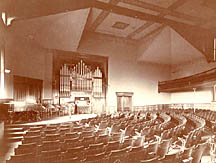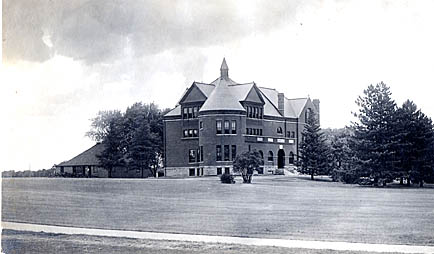Bats, bees, camel part of Morrill history
By John Anderson
Wallace Stegner, a University of Wisconsin graduate and Pulitzer Prize-winning author, wrote, "The truth is, a place is more than half memory. No place is a place until things that have happened in it are remembered."
That's very true of Iowa State University and all of the buildings that make up the campus. And the older the building, the more things that have happened in it that are remembered.
Morrill Hall is such a place, filled with stories and filled with memories.
Unfortunately, not a lot of the stories have been written down. Rather, they are simply a part of the folklore -- handed down from occupant to occupant.
The history of Morrill could be called: "Morrill Hall: Chapel Library Museum" or "Morrill Hall: Bats and Bees; Camels and Mules."
It's actually both. Here's a little about its history as the Chapel Library Museum, and later as a classroom and office building, and some of the stories passed on by those who have worked in the building over the past years.
The history
The need for a building first arose in 1870, only two years after Iowa State opened. The College Board minutes read: "Next to the men that teach its students and to the men that control its affairs, the library and museum are the most important means of building up a great institution."
In typical political fashion -- then and now -- 20 years later, a library and museum building was approved, and the building was named after Sen. Justin Morrill, author of the land-grant legislation.
Naming the building after Sen. Morrill was significant since Iowa was the first state in the nation to accept the terms of the Morrill Act (1862) and Iowa State was the first institution to be designated a land-grant institution (1864) -- even though all that was here at the time was the Model Farm.
Morrill Hall was built at cost of $28,739 and dedicated on June 16, 1891. Professor Charles Bessey was principal speaker and a letter of congratulations was read from Sen. Morrill.
Over the entrance of Morrill Hall were the words "Chapel Library Museum," for its three principal uses. However, another principal use was for classrooms and laboratories for zoology, entomology and geology, and part of the basement was used as a physical education gymnasium.
Chapel

The chapel in Morrill Hall, about 1891
- Chapel services were compulsory from the beginning on weekdays and Sundays (Saturdays off).
- Before a chaplain was appointed, chapel was conducted by the university president.
- O.H. Cessna, a member of Iowa State's first graduating class of 1872, came back in 1900 as a professor and head of history. He also was appointed chaplain in 1902 and served in that role until his death in 1929.
- Daily chapel was discontinued during World War I as more churches became established in Ames. Four were located near the campus and two downtown churches established student centers near the campus.
- Sunday chapel was discontinued in 1929 with the death of Professor Cessna.
- Chapel also was the main performing arts stage for the college (music, speech, drama). No doubt, George Washington Carver (the first African American to graduate from ISU and who went on to become a world-famous scientist) performed on that stage, as he was highly talented in vocal music, drama, speech and poetry.
Library

The library in Morrill Hall, about 1910
- The library was located in Old Main (which later was replaced by Beardshear Hall) until it was moved to the new Morrill Hall in 1891. It was located on the main floor.
- The library moved from Morrill Hall to Beardshear Hall in 1913, then to the new library building in 1925.
Museum
- The museum occupied the entire third floor (north side) of Morrill Hall.
- Specimens in the museum were not just of native species, but also monkeys, alligator, an aardvark and even a camel (more on that, later).
- The museum remained in Morrill Hall at least through 1930 (a 1930 newspaper account says "the old museum still remains.")
In his 1891 college report, President William Beardshear had glowing things to say about Morrill Hall, calling the chapel a "gem" and including this: "The basement is well utilized by a flourishing gymnasium and rooms for the preparation of subjects of natural history and display of fishes." (One can only imagine what the combination of sweat socks and dead fish must have smelled like. It wasn't long before faculty complained, not about the smell, but that the ceiling was too low and the room too small for physical education and gymnastics.)
Other uses
- The first change came in 1905 when the faculty petitioned to convert a room in the southeast corner of the basement to a barber shop. The barber shop remained there until 1913, when the basement was converted to a file room and office -- the beginning of administrative use of Morrill Hall.
- Music education: The first Music Hall actually was a house built for Professor George Jones in 1870. It was remodeled and enlarged in 1899 for other purposes. It was remodeled again in 1929 to become Music Hall. Music quickly outgrew it and expanded into other buildings, including Morrill Hall, where large groups practiced and several faculty had offices on the third floor of the turret, including university carillonneurs Ira Schroeder and then Dick Von Grabow. Music programs consolidated in the new Music Building in 1980, basically vacating that part of Morrill Hall.
- Extension: The earliest record of Extension in Morrill Hall comes from a 1930 newspaper clipping that says the chapel was used for county agent meetings. Extension remained there in Morrill Hall until 1996, and was its last occupant.
- Information and communication: This was probably an outgrowth of Extension. Along with Extension and Information, there were Photography Services, Ag and Home Economic Experiment Station Communication, Sports Information and a university Publications Office in Morrill Hall. All have since moved on to other locations.
Stories
Bees and bats
Bats and bees are considered the resident denizens of Morrill Hall. They were there ever since the building was built and they're there now.
Staff always complained about bees flying around. They thought the bees came in through the deteriorating windows. However, when work crews broke into a wall as part of a minor remodeling project on the third floor, they found a massive bee hive. The workers called entomology, and the beehive was removed -- along with a huge amount of honey.
Bats were a constant nuisance. They really enjoyed flying around the chapel but occasionally would get loose in other parts of the building. Those who worked in Morrill Hall could tell a bat was loose by the slamming of doors. They would call Facilities, who would send staff over to catch the bat and release it outside. The bat probably flew right back into the building through a hole somewhere.
Mule hair
In the early 1980s, the roof on Morrill Hall was replaced. As part of this, crews inspected the underlying support structure from the inside. What they found when they got up close alarmed them. The mortar had a fibrous material in it and the first thing the workers thought of was asbestos.
The third floor was sealed off and crews with haz-mat suits were sent in to collect samples. What they found was not asbestos, but that the original building mortar had mule hair used as a binder.
The camel
The following comes from an account by John Hungerford, an 1878 graduate:
For many years, there was a stuffed camel in the Morrill Hall Museum on the third floor. How did it get there?
It seems that sometime in the 1870s, a circus came to Ames, and as was traditional, the circus performers and animals were paraded through the downtown to promote its shows. Right in the middle of the parade and right in the middle of the downtown, the circus camel keeled over and died.
One of the spectators was a student named Billy Bryan, who loved taxidermy and had already caught, killed and stuffed dozens of native animals, many of which he donated to the college.
He saw the camel die and immediately went up to the circus manager and offered to take the carcass off his hands -- at no charge. Being a warm day, it didn't take long for the circus manager to agree.
Bryan's goal was to stuff the camel and he did. Hungerford, who assisted in the process, noted, "Why, that camel was restored to life-like appearance, everything but the wicked look in the eye was restored and made to look as if the critter was alive and enjoying good health."
Bryan went on to fame as a scientist, author and one of the most famous taxidermists in the United States. He headed the museum in Exposition Park in Los Angeles for many years.
The camel stayed behind after Bryan graduated, being moved around campus until Morrill Hall was built and it was added to the college museum collection on the third floor.
The story doesn't end there. Indeed, it has a sad ending.
The camel died -- again -- this time rather ignominiously. The details are unclear, but either a water pipe burst or a torrential rain leaked in. The result was the stuffed camel was soaked -- and it exploded. It was then unceremoniously discarded.
Other stories
- Students would wander in looking for the library -- in the 1990s -- during spring semester.
- In later years, the balcony was a favorite spot for watching Veishea parades. Unfortunately, students had to be told to leave because it wasn't safe.
- Several times, students put a pumpkin on top of the turret as a Halloween prank, but in the early 1980s, some enterprising students constructed a giant pumpkin out of wood frame, chicken wire and paper-mache. How they got it up on the turret, no one knows. It stayed there for a couple of weeks and took a special boom truck and a crew of four most of a day to get down.
- A small conference area was located right under the turret stairs that go up to the chapel auditorium. Many mentioned that during class break time for the music groups, the thundering herd of music students going up and down the stairs caused pieces to fall off the ceiling onto the conference table.
- A sprinkler system installed in the early 1990s cost more than the building itself.
- The university shut down over one winter holiday break to save heating costs. The steam system in Morrill Hall went berserk -- hitting over 95 degrees for more than a week until someone finally came in to check on it. The floors had buckled and the heat had killed every plant in the building.

Morrill Hall, about 1915. Photos provided by Iowa State University Library/Special Collections Department